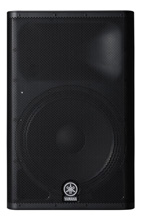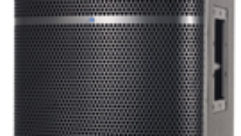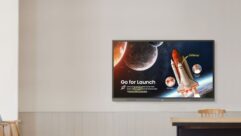

Yamaha DXR Series Speakers Review
Aug 14, 2012 4:31 PM,
Reviewer: John McJunkin
PAs that deliver loudness and fidelity on a small budget.
If I were asked, “Is the market for small, portable, self-powered PA speakers saturated?” my answer to the question would be, “Absolutely, yes.” Every major pro audio manufacturer has at least one model available and I might be able to come up with the name of an organization that exists only to serve that market. There is demand out there for these speakers with a broad array of features, in a wide variety of sizes, with varying degrees of power, and with an extensive range of pricing. These are the speakers with which the vast majority of public address, audiovisual, and light sound-reinforcement work is accomplished. They’re used by professionals and amateurs alike, in applications as widely distinct as a single speaker with an 8in. LF driver used in a coffee shop poetry slam to a 16-cabinet FOH rig for a heavy metal show in a 1,000-seat venue and beyond. No small wonder why there are so many options available; there are buyers who demand them.
Yamaha’s DSR line of self-powered speakers has emerged as a major contender in the market. An excellent line of speakers that delivers an astonishing amount of sound pressure level with remarkable fidelity, I got an up-close look at a DSR system (consisting of two 15in. full-range speakers and two 18in. subwoofers) last year, and was impressed. The DSRs offer a nice blend of power, fidelity, and bells and whistles.
At the 2012 NAMM convention, Yamaha introduced a similar line at a lower price: the DXR series. The main distinctions between the two lines are in the domains of power, SPL, materials, weight, and minor differences in frequency response. The DXR series consists of four models, and I evaluated a DXR system consisting of two 15in. full-range speakers and one 15in. subwoofer (specifically, two DXR15s and a DXS15), and I’ll be referring specifically to the two systems I evaluated as I compare the lines throughout this review. There is no single 15in. subwoofer in the DSR line for a fair comparison with the DXS15, so there will be no comparisons between subs. The DXR15 is the largest of the full-range speakers, and there is also a 12in. sub in the DXS line.
The DSR full-range speaker’s amps deliver a total of 1,300W, compared with the 1100W delivered by the DXR’s amps. This is the main reason for the 3dB SPL advantage the DSR has over the DXR, 136dB SPL vs. 133dB SPL, respectively. The full-range DXR speakers weigh 11lb. lighter than their DSR counterparts: 50lb. and 61lb., respectively. The main reason for the difference is the fact that DSRs are constructed of wood, while the DXRs are formed of ABS plastic. And while the published upper frequency response limit is 20kHz, the DSRs deliver lower lows—45Hz vs. the 49Hz limit of the DXRs.
Another minor distinction between the two lines is the use of neodymium magnets in the DSR series and ferrite magnets in the DXRs, resulting in higher fidelity from the DSR’s LF drivers. One other notable distinction is the substantially more extensive input/output and more sophisticated mixing conventions of the DXR. In recent years, most speaker-on-a-stick manufacturers have worked to meet the demand for more I/O and better control at the speaker for the benefit of users who may not use a mixer or other signal processing—think of a singer/songwriter with a guitar in a coffee shop.
Yamaha DXR Series Speakers Review
Aug 14, 2012 4:31 PM,
Reviewer: John McJunkin
PAs that deliver loudness and fidelity on a small budget.

DSX15
Clearly, the DSR is the more powerful speaker in a more robust enclosure, but the DXR compensates for lesser power and a stronger box with a lighter, less backbreaking cabinet and more sophistication in the I/O. The DXR features the most extensively appointed rear panel I’ve ever seen in a speaker-on-a-stick, with two 1/4in. balanced/unbalanced, two RCA unbalanced, and a switchable XLR mic/line input, each with its own level control. Stereo inputs are summed to mono and mixed internally. A contour switch alters the spectral balance of the speaker’s output with a choice of three settings: monitor, cut low end and boosted high end; off, no alteration; and FOH/main – scooped-mids loudness setting. A HPF can be switched in, with a cutoff frequency of either 100Hz or 120Hz. LEDs indicate limiting, signal presence, protection circuit activation, and power status. A pushbutton toggles the LED on the front of the speaker on and off. Finally, an XLR output jack passes along a “link out” daisychain feed to additional speakers if necessary, either in dual mono or stereo mode.
The DXS subwoofer offers two XLR inputs with a single level knob for two-channel LF operation, along with two XLR passthrough outputs for 2.1 satellite configurations. The DXS features the same compliment of LED indicators and front LED disable switch as the DXR speaker, along with polarity and dynamic D-XSUB bass boost switches and an LPF with cutoff frequencies of 80Hz, 100Hz, and 120Hz. All signal processing in both types of speaker is digital and is accomplished with a sample rate of 48kHz and 24 bits of amplitude resolution.
Setup is easy. I mounted the DXRs on tripods, but the DXS also offers a pole socket so the full-range speaker can be placed on a pole directly above the subwoofer. Connection is also very simple, with signal passing through the subwoofer on to the full-range speakers. I fed the output of a mixer in a small performance venue to the full system, but I also fed a single DXR with an iPhone, a computer, and a portable CD player. The DXR speakers by themselves deliver a huge amount of SPL—the published 133dB is not an exaggeration. The published 132dB SPL over a range of 45Hz to 160Hz from the DXS is also no flight of fancy. For better or worse, there are clients who seek raw loudness, and these speakers deliver. They also deliver excellent fidelity, even at ridiculously high volume levels. I found the response smooth—linear phase FIR filters facilitate an even transition through the crossover point of 2.1kHz. Having heard the DSR speakers prior, the high end of the DXRs seems tamer, but in a good way.
With the contour switch in the FOH/main position (intended for applications lacking a subwoofer), the DXRs convey amazing low end. The addition of a sub in a 2.1 configuration facilitates applications like gymnasiums and other small to mid-size venues, particularly for DJs. Combos and larger bands may want to double up subwoofers to get more low end. For corporate and AV applications, these speakers deliver more SPL than will likely ever be necessary, but they’re also accurate, so they are a good choice for a contractor who needs to specify a speaker that offers both power and quality.
I was very pleased with the Yamaha DSR series speakers I’d worked with prior, so I was anxious to hear whether Yamaha would be able to deliver a less expensive speaker with powerful, high-quality reproduction like the DSR at a lower price point. The DXR represents exactly that. Consider them if you’re working with a smaller budget and need loudness and fidelity.
Product Summary
Pros: Breathtakingly loud and remarkably accurate
Cons: No major cons
Applications: Small to mid-size venues, DJs, solo musicians or small combos, PA, AV
Price: $1,199 MSRP/$799.99 street (DXR15); $1,199 MSRP/$799.99 street (DXS15)
Specifications:
DXR15
Frequency range (-10dB): 49Hz – 20kHz
Coverage angle: H90°∆ x V60°∆ Constant Directivity Horn
Crossover type: FIR-X tuning™ (Linear Phase FIR Filter)
Crossover frequency: 2.1kHz
Maximum SPL (peak) IEC noise@1m: 133dB SPL
Floor monitor angle: 50°∆ symmetrical
Dimensions (WxHxD, with rubber feet): 17.5″x27.5″x15″
Net weight: 22.5kg (49.6lbs)
Amplifier type: Class-D
Power rating: Dynamic: 1100W (LF: 950W, HF: 150W); Continuous: 700W (LF: 600W, HF: 100W)
AD/DA: 24-bit 48kHz sampling
Signal processing: 48-bit (Accumulator: 76-bit)
HPF/LPF: OFF, 100, 120Hz 24dB/oct HPF
Input impedance:
INPUT1 LIN: 12kΩ
MIC: 8kΩ
INPUT2, 3 L, R: 40kΩ
MONO: 20kΩ
Input sensitivity (level maximum):
INPUT1 LINE: +1dBu
MIC: -32dBu
Input sensitivity (level center):
INPUT1 LINE: +11dBu
MIC: -22dBu
INPUT2, 3: -3dBu
Maximum input level:
INPUT1 LINE: +24dBu
MIC: +20dBu
INPUT2, 3: +16dBu
DXS15
Frequency range (-10dB): 47Hz – 160Hz
Maximum SPL (peak) IEC noise@1m: 132dB SPL
Dimensions (WxHxD, with rubber feet): 18-7/8″x24-3/8″x24-1/2″
Net weight: 38.0kg (83.8lbs.)
Amplifier type: Class-D
Power rating: Dynamic: 950W; Continuous: 600W
AD/DA: 24-bit 48kHz sampling
Signal processing: 48-bit (Accumulator: 76-bit)
HPF/LPF: 80, 100, 120Hz 24dB/oct LPF
Input impedance:
INPUT1 LIN: 10kΩ
MIC: 8kΩ
INPUT2, 3 L, R: 40kΩ
MONO: 20kΩ
Input sensitivity (level maximum):
INPUT1 LINE: +1dBu
MIC: -32dBu
Input sensitivity (level center):
INPUT1 LINE: +11dBu
MIC: -22dBu
INPUT2, 3: -3dBu
Maximum input level:
INPUT1 LINE: +24dBu
MIC: +20dBu
INPUT2, 3: +16dBu
John McJunkin is the principal of Avalon Podcasting in Chandler, Ariz. He has consulted in the development of studios and installations and provides high-quality podcast production services.










